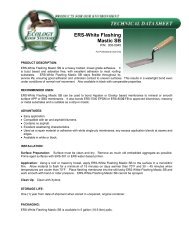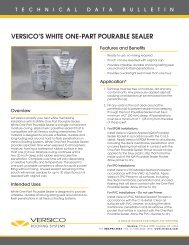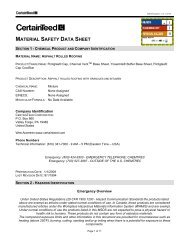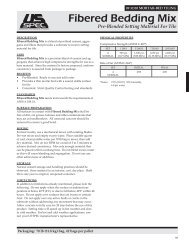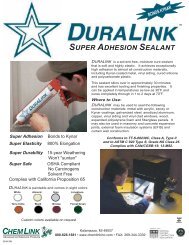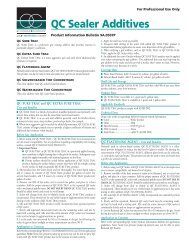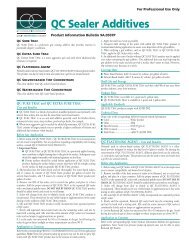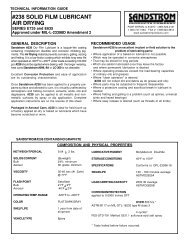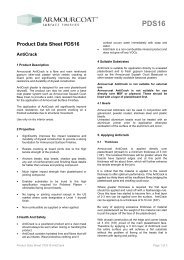Simpson Anchors - Anchoring and Fastening Systems - BuildSite.com
Simpson Anchors - Anchoring and Fastening Systems - BuildSite.com
Simpson Anchors - Anchoring and Fastening Systems - BuildSite.com
Create successful ePaper yourself
Turn your PDF publications into a flip-book with our unique Google optimized e-Paper software.
C-SAS-2009 © 2009 SIMPSON STRONG-TIE COMPANY INC.<br />
GLOSSARY OF COMMON TERMS<br />
ACI - American Concrete Institute<br />
ACRYLIC - The generic term for adhesive products made<br />
from methylmethacrylate resins.<br />
ADHESIVE ANCHOR - Typically, a threaded rod or rebar which is installed<br />
in a predrilled hole in a base material with a two part chemical <strong>com</strong>pound.<br />
ADMIXTURE - A material other than water, aggregate, or hydraulic cement<br />
used as an ingredient of concrete <strong>and</strong> added to concrete before or during<br />
its mixing to modify its properties.<br />
AERATED CONCRETE - Concrete that has been mixed with air-entraining<br />
additives to protect against freeze-thaw damage <strong>and</strong> provide additional<br />
workability.<br />
AGGREGATE - A granular material, such as s<strong>and</strong>, gravel, crushed stone<br />
<strong>and</strong> iron blast-furnace slag, used with a cementing medium to form a<br />
hydraulic cement concrete or mortar.<br />
AISC - American Institute of Steel Construction<br />
ALLOWABLE LOAD - The maximum design load that can be applied to an<br />
anchor. Allowable loads for mechanical <strong>and</strong> adhesive anchors are based on<br />
applying a factor of safety to the average ultimate load.<br />
ALLOWABLE STRESS DESIGN (ASD) - A design method in which an<br />
anchor is selected such that service loads do not exceed the anchor’s<br />
allowable load. The allowable load is the average ultimate load divided by<br />
a factor of safety.<br />
AMINE - An ingredient used in epoxy as a curing agent.<br />
ANCHOR CATEGORY - The classifi cation for an anchor that is established<br />
by the performance of the anchor in reliability tests such as sensitivity to<br />
reduced installation effort for mechanical anchors or sensitivity to hole<br />
cleaning for adhesive anchors.<br />
ANSI - American National St<strong>and</strong>ards Institute<br />
ASTM - American Society for Testing <strong>and</strong> Materials<br />
BASE MATERIAL - The substrate (e.g. - concrete, CMU, etc.) into which<br />
adhesive or mechanical anchors are to be installed.<br />
BOND STRENGTH - The mechanical interlock or chemical bonding<br />
capacity of an adhesive to both the insert <strong>and</strong> the base material.<br />
BRICK - A solid masonry unit of clay or shale, formed into a rectangular<br />
prism while plastic <strong>and</strong> burned or fi red in a kiln that may have cores or<br />
cells <strong>com</strong>prising of less than 25% of the cross sectional area.<br />
CAMA - Concrete Anchor Manufacturer's Association.<br />
CAST-IN-PLACE ANCHOR - A headed bolt, stud or hooked bolt installed<br />
into formwork prior to placing concrete.<br />
CHARACTERISTIC DESIGN VALUE - The nominal strength for which there<br />
is a 90% confi dence that there is a 95% probability of the actual strength<br />
exceeding the nominal strength.<br />
CONCRETE - A mixture of portl<strong>and</strong> cement or any other hydraulic cement,<br />
fi ne aggregate, coarse aggregate <strong>and</strong> water, with or without admixtures.<br />
Approximate weight is 150 pcf.<br />
CONCRETE BRICK - A solid concrete masonry unit (CMU) made from<br />
portl<strong>and</strong> cement, water, <strong>and</strong> aggregates.<br />
CONCRETE COMPRESSIVE STRENGTH (f' c ) - The specifi ed <strong>com</strong>pressive<br />
load carrying capacity of concrete used in design expressed in pounds per<br />
square inch (psi) or megapascals (MPa).<br />
CONCRETE MASONRY UNIT (CMU) - A hollow or solid masonry unit made<br />
from cementitious materials, water, <strong>and</strong> aggregates.<br />
CORE DRILL - A method of drilling a smooth wall hole in a base material<br />
using a special drill attachment.<br />
CREEP - Displacement under a sustained load over time.<br />
CURE TIME - The elapsed time required for an adhesive anchor to develop<br />
its ultimate carrying capacity.<br />
DESIGN LOAD - The calculated maximum load which is to be applied to<br />
the anchor for the life of the structure.<br />
DESIGN STRENGTH - The nominal strength of an anchor calculated per<br />
ACI 318, ICC-ES AC193 or ICC-ES AC308 <strong>and</strong> then multiplied by a strength<br />
reduction factor (φ).<br />
DROP-IN ANCHOR - A post-installed mechanical anchor consisting of an<br />
internally-threaded steel shell <strong>and</strong> a tapered exp<strong>and</strong>er plug. The bottom<br />
end of the steel shell is slotted longitudinally into equal segments. The<br />
anchor is installed in a pre-drilled hole using a hammer <strong>and</strong> a h<strong>and</strong> setting<br />
tool. The anchor is set when the tapered exp<strong>and</strong>er plug is driven toward<br />
the bottom end of the anchor such that the shoulder of the h<strong>and</strong> setting<br />
tool makes contact with the top end of the anchor. A Drop-In Anchor may<br />
also be referred to as a Displacement Controlled Expansion Anchor.<br />
DYNAMIC LOAD - A load whose magnitude varies with time.<br />
EDGE DISTANCE:<br />
EDGE DISTANCE (C) - The measure between the anchor<br />
centerline <strong>and</strong> the free edge of the concrete or masonry member.<br />
CRITICAL EDGE DISTANCE (C cr or C ac ) - The least edge distance<br />
at which the allowable load capacity of an anchor is applicable<br />
without reductions.<br />
MINIMUM EDGE DISTANCE (C min ) - The least edge distance<br />
at which the anchors are tested for recognition.<br />
EFFECTIVE EMBEDMENT DEPTH - The dimension measured from the<br />
concrete surface to the deepest point at which the anchor tension load is<br />
transferred to the concrete.<br />
EMBEDMENT DEPTH - The distance from the top surface of the base<br />
material to the installed end of the anchor. In the case of a post-installed<br />
mechanical anchor, the embedment depth is measured prior to application<br />
of the installation torque.<br />
EPOXY - A thermosetting resin made by <strong>com</strong>bining mainly Dyglycydal<br />
Ether or Bisphenol-A <strong>and</strong> a Polyamine curing agent.<br />
EXPANSION ANCHOR - A mechanical fastener placed in hardened<br />
concrete or assembled masonry, designed to exp<strong>and</strong> in a self-drilled or<br />
predrilled hole of a specifi ed size <strong>and</strong> engage the sides of the hole in one<br />
or more locations to develop shear <strong>and</strong>/or tension resistance to applied<br />
loads without grout, adhesive or drypack.<br />
FATIGUE LOAD TEST - A test in which the anchor is subjected to a<br />
specifi ed load magnitude for 2 x 10 6 cycles in order to establish the<br />
endurance limit of the anchor.<br />
GEL TIME - The elapsed time at which an adhesive begins to increase<br />
in viscosity <strong>and</strong> be<strong>com</strong>es resistant to fl ow.<br />
GREEN CONCRETE - Concrete that has cured for less than 28 days.<br />
GROUT - A mixture of cementitious material <strong>and</strong> aggregate to which<br />
suffi cient water is added to produce pouring consistency without<br />
segregation of the constituents.<br />
GROUTED MASONRY (or GROUT-FILLED MASONRY) -<br />
Hollow-unit masonry in which the cells are fi lled solidly with grout.<br />
Also, double or triple-wythe wall construction in which the cavity(s)<br />
or collar joint(s) is fi lled solidly with grout.<br />
HOT-DIP GALVANIZED - A part coated with a relatively thick layer<br />
of zinc by means of dipping the part in molten zinc. Hot-dip<br />
galvanizing provides a medium level of corrosion resistance.<br />
ICC ES - International Code Council Evaluation Service.<br />
LIGHTWEIGHT CONCRETE - Concrete containing lightweight aggregate.<br />
The unit weight of lightweight concrete is not to exceed 115 pcf.<br />
MASONRY - Brick, structural clay tile, stone, concrete masonry units,<br />
or a <strong>com</strong>bination thereof bonded together with mortar.<br />
MECHANICALLY GALVANIZED - A part coated with a layer of zinc<br />
by means of mechanical impact. The thickest levels of mechanical<br />
galvanizing (ASTM B695, Class 55 or greater) are considered to be<br />
alternatives to hot-dip galvanizing <strong>and</strong> provide a medium level<br />
of corrosion resistance<br />
MERCAPTAN - An ingredient used in epoxy as a curing agent.<br />
MORTAR - A mixture of cementitious materials, fi ne aggregate,<br />
<strong>and</strong> water, used to bond masonry units together.<br />
NOMINAL STRENGTH - The strength of an element as calculated per ACI<br />
318, ICC-ES AC193 or ICC-ES AC308.<br />
NORMAL WEIGHT CONCRETE - Concrete containing normal weight<br />
aggregate. The unit weight of normal weight concrete is approximately<br />
150 pcf.<br />
221



